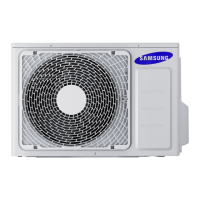Do you have a question about the Samsung RJ100F5HXEA and is the answer not in the manual?
Guidelines for safe and correct indoor unit installation procedures.
Electrical connection and safety requirements for power supply.
Safety guidelines for operating the air conditioner to prevent hazards.
Environmentally responsible disposal procedures for the air conditioner.
Miscellaneous safety and handling instructions not covered elsewhere.
Overview of key features and capabilities of the air conditioner series.
Comprehensive technical specifications for various indoor units.
Comparison of specifications between different development and comparative models.
Specifications for available accessories and optional components.
Lists essential tools required for unit disassembly and reassembly.
Step-by-step guide for disassembling RJ040/RJ050 outdoor units.
Step-by-step guide for disassembling RJ060/RJ070/RJ080 outdoor units.
Step-by-step guide for disassembling RJ100F5HXEA outdoor units.
Detailed procedure for disassembling the Assy Control Out component.
Identifies error codes and provides initial checks for indoor units.
Guide to configuring unit options using the remote control.
Lists initial checks for common operational issues before detailed diagnosis.
Procedures for verifying correct installation and operation after setup.
Diagnosing issues based on specific symptoms like sensor errors or fan malfunctions.
Detailed diagrams and part numbers for indoor unit components.
Detailed diagrams and part numbers for outdoor unit components.
Parts list specifically for the Assy Control Out assembly.
Circuit diagrams for various indoor unit main and sub PCBs.
Circuit diagrams for various outdoor unit main and sub PCBs.
Electrical wiring schematics for different indoor unit models.
Electrical wiring schematics for different outdoor unit models.
Detailed circuit schematics for indoor unit components.
Detailed circuit schematics for outdoor unit components.
Guidelines for choosing optimal locations for indoor and outdoor units.
Procedure for connecting refrigerant lines and purging air from the system.
Steps for refilling refrigerant after installation or leak.
Adjusting refrigerant based on pipe length and installation conditions.
Correct torque values for tightening flare nuts during installation.
Method for safely extracting refrigerant from the system.
Reference guide for understanding model naming conventions.
Visual representation of the refrigerant cycle for different models.
Definitions and values for pressure and capacity markings.
Glossary of technical terms used in the manual.
Common non-trouble issues and their solutions for user convenience.
Basic principles of refrigeration and air supply for context.
| Model | RJ100F5HXEA |
|---|---|
| Inverter | Yes |
| EER | 3.5 |
| Power Supply | 220V - 240V, 50Hz |
| Operating Temperature (Cooling) | 18°C to 43°C |












